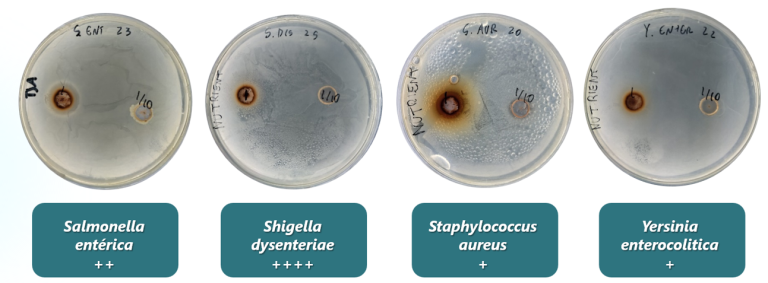To effectively mitigate the impact of mycotoxins on animal production, a multidisciplinary approach is essential, integrating agricultural, veterinary, and technological strategies. This comprehensive effort ensures livestock health, welfare, and productivity, while safeguarding the quality and safety of food products for human consumption (Tolosa et al., 2021).
Feedstuffs contaminated with mycotoxin can result in serious performances and economic losses, due to the detrimental effect of these metabolites on animal health. Mycotoxins interfere with the integrity of the gut barrier, resulting in the translocation of bacteria and subsequent adverse effects induced by endotoxins (such as Salmonella enterica) (Figure 1).

Figure 1. Mycotoxins side effects.
The intestinal epithelium represents the primary tissue exposed to mycotoxins and other pathogenic agents (Antonissen et al. 2014). Some of the detrimental effects observed during mycotoxin exposure are the reduction of intestinal integrity, increased intestinal permeability, weak immune function, and increased oxidative stress, which lead to cell damage, inflammation, and alterations in liver function (Yang et al., 2020).
Intestinal dysbiosis can have a negative impact on both animal health and productivity. Pathogenic microorganisms of the gastrointestinal tract include: Salmonella enterica, Staphylococcus aureus, Shigella dysenteriae and Yersinia enterocolitica.
The clinical importance of Salmonella has been recognized not only because of the induced effects in different animal production species, but also due to the risk it represents for consumers. At the animal level, this microorganism induces inappetence, fever and wet cough, which together result in extended mortality rate and decreased performance (Blaha et al., 2000).
Likewise, Staphylococcus aureus may cause diseases such as mastitis, articular and skin infections in ruminants (Patel et al., 2019); while in broilers it can cause articular infections such as bacterial chondronecrosis with osteomyelitis (Szafraniec et al., 2022). On the other hand, Shigella dysenteriae and Yersinia enterocolitica, besides the negative impact on animal growth in the early stages, can contaminate products, compromising food safety (Nwoush et al., 2007).
Therefore, in order to reduce the metabolic effects induced by mycotoxins, the potential of plant-derived products (e.g. extracts or essential oils) has been investigated, due to their antifungal, antioxidant and immunomodulatory properties (Murugesan et al., 2015).
In particular, some studies have shown that grape extract, due to its high content of polyphenols and flavonoids (more than 80% of its total composition), such as proanthocyanidin, presents a high antioxidant and anti-inflammatory activity (Abdel-Moneim et al., 2020). Another example is provided by olive extract, which has shown a high antimicrobial activity, as it exerts a negative effect against cell membranes of Gram-negative and Gram-positive bacteria (Alqahtani et al., 2019, Nunes et al., 2021).
Moreover, the presence of its key active compound, hydroxytyrosol, has been shown to enhance liver health and reduce oxidative stress (Wang et al., 2023).
Based on these novel results, BIŌNTE has developed BIŌNTE® QUIMITŌX® LIVŌX®.
BIŌNTE® QUIMITŌX® LIVŌX®: A liquid solution to counteract the collateral effects of mycotoxin
BIŌNTE® QUIMITŌX® LIVŌX® has been specifically developed to deal with the secondary mycotoxin effects and to promote animal health holistically.
For these reasons, BIŌNTE® QUIMITŌX® LIVŌX® includes selected high-quality phytogenic ingredients, such as grape extract and olive extract, with high antioxidant, hepatoprotective and anti-inflammatory properties. Additionally, other valuable ingredients, such as emulsifiers, preservatives and minerals are incorporated to preserve and enhance these beneficial effects. As demonstrated in different studies (Guerra et al., 2005; Sorrenti et al., 2012), the grape and olive extracts reduces the toxicity of mycotoxins (Guerra et al., 2005; Sorrenti et al., 2012).

For all these reasons, BIŌNTE® QUIMITŌX® LIVŌX® provides an innovative liquid solution specifically designed to meet the challenges faced by animal production.
BIŌNTE® QUIMITŌX® LIVŌX® antimicrobial activity: In vitro evaluation against several gastrointestinal pathogenic microorganisms
In our previous study, BIŌNTE® QUIMITŌX® LIVŌX® demonstrated a high antioxidant activity. Thus, we carried out an in vitro trial, in collaboration with Microlab Biotech (University of Valencia), to evaluate the antimicrobial capacity of BIŌNTE® QUIMITŌX® LIVŌX®. The solution was tested against those microorganisms that usually induce alteration in the GIT, like Salmonella enterica (SAL), Shigella dysenteria (SHI), Staphylococcus aureus (STA) and Yersinia enterocolitica (YER).
The in vitro antimicrobial activity of the complex was tested using 15 mL of the specific growth medium for each microorganism. The agars were allowed to solidify at room temperature and the corresponding pathogenic micro-organism was seeded on each petri plate using a digralsky loop. Then, 10 μL of the complex, was incorporated into the center of the plates. After incubation at 28 °C for 24 h, microbial growth was visually observed and the growth inhibition halo (mm) for each pathogenic micro-organism in the presence of the tested product was determined in triplicate (Figure 2).

Figure 2. Material and methods.
Results in Figure 3 shows the antimicrobial activity of BIŌNTE® QUIMITŌX® LIVŌX® against the microorganisms S. Dysenteriae, S. entericae, S. aureus and Y. Enterocolitica, being S. dysenteriae the most sensitive microorganism to the tested formulation, with an inhibition halo of 10mm.

Figure 3. Inhibition halo.
At the farm level, managing risk factors such as feed contamination and maintaining gut health are critical to reducing the prevalence of pathogens. These interventions not only improve animal health and productivity but also protect food quality and safety for consumers. BIŌNTE® QUIMITŌX® LIVŌX® has a high antimicrobial activity, thus providing an effective liquid solution to counteract the side effects of mycotoxins.
Conclusion
BIŌNTE® QUIMITŌX® LIVŌX® is a liquid solution containing phytogenics, with antioxidant and anti-inflammatory properties. In addition, this liquid solution has proven to have a potent antimicrobial capacity, as it reduces the growth of pathogenic microorganisms of the gastro intestinal tract, such as Salmonella enterica, Staphylococcus aureus, Shigella dysenteriae and Yersinia enterocolitica, thus protecting animals from these pathogens.



